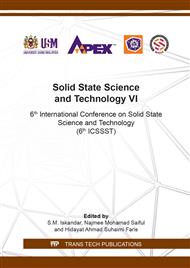[1]
O. Veiseh, C. Sun, J. Gunn, N. Kohler, P. Gabikian, D. Lee, N. Bhattarai, R. Ellenbogen, R. Sze, A. Hallahan, J. Olson, and M. Zhang, Optical and MRI Multifunctional Nanoprobe for Targeting Gliomas, Nano Lett., vol. 5, no. 6, p.1003–1008, (2005).
DOI: 10.1021/nl0502569
Google Scholar
[2]
M. Karhanek, J. T. Kemp, N. Pourmand, R. W. Davis, and C. D. Webb, Single DNA Molecule Detection Using Nanopipettes and Nanoparticles, Nano Lett., vol. 5, no. 2, p.403–407, (2005).
DOI: 10.1021/nl0480464
Google Scholar
[3]
J. Panyam and V. Labhasetwar, Biodegradable Nanoparticles for Drug and Gene Delivery to Cells and Tissue, Adv. Drug Deliv. Rev., vol. 55, p.329–347, (2003).
DOI: 10.1016/s0169-409x(02)00228-4
Google Scholar
[4]
X. Huang and M. A. El-sayed, Gold nanoparticles : Optical Properties and Implementations in Cancer Diagnosis and Photothermal Therapy, J. Adv. Res., vol. 1, p.13–28, (2010).
DOI: 10.1016/j.jare.2010.02.002
Google Scholar
[5]
L. R. Hirsch, R. J. Stafford, J. A. Bankson, S. R. Sershen, B. Rivera, R. E. Price, J. D. Hazle, N. J. Halas, and J. L. West, Nanoshell-Mediated Near-Infrared Thermal Therapy of Tumors Under Magnetic Resonance Guidance, Proc Natl Acad Sci, vol. 100, no. 23, p.13549–13554, (2003).
DOI: 10.1073/pnas.2232479100
Google Scholar
[6]
O. V Salata, Applications of Nanoparticles in Biology and Medicine, J. Nanobiotechnology, vol. 6, p.1–6, (2004).
Google Scholar
[7]
B. D. Chithrani, A. A. Ghazani, and W. C. W. Chan, Determining the Size and Shape Dependence of Gold Nanoparticle Uptake into Mammalian Cells, Nano Lett., vol. 6, no. 4, p.662–668, (2006).
DOI: 10.1021/nl052396o
Google Scholar
[8]
G. Sonavane, K. Tomoda, and K. Makino, Biodistribution of Colloidal Gold Nanoparticles After Intravenous Administration: Effect of Particle Size., Colloids Surf. B. Biointerfaces, vol. 66, no. 2, p.274–80, Oct. (2008).
DOI: 10.1016/j.colsurfb.2008.07.004
Google Scholar
[9]
W. Jiang, B. Y. S. Kim, J. T. Rutka, and W. C. W. Chan, Nanoparticle-Mediated Cellular Response is Size-Dependent., Nat. Nanotechnol., vol. 3, no. 3, p.145–50, Mar. (2008).
Google Scholar
[10]
D. B. Chithrani, Optimization of Bio-Nano Interface Using Gold Nanostructures as a Model Nanoparticle System, Insciences J., vol. 1, no. 3, p.115–135, Jul. (2011).
DOI: 10.5640/insc.0103115
Google Scholar
[11]
H. Gao, W. Shi, and L. B. Freund, Mechanics of Receptor-Mediated Endocytosis., Proc. Natl. Acad. Sci. U. S. A., vol. 102, no. 27, p.9469–74, Jul. (2005).
DOI: 10.1073/pnas.0503879102
Google Scholar
[12]
S. R. Makhsin, K. A. Razak, A. A. Aziz, and R. Noordin, Study on Controlled Size, Shape and Dispersity of Gold Nanoparticles (AuNPs) Synthesized via Seeded-Growth Technique for Immunoassay Labeling, Adv. Mater. Res., vol. 364, p.504–509, Oct. (2011).
DOI: 10.4028/www.scientific.net/amr.364.504
Google Scholar
[13]
N. S. Rosli, A. Abdul Rahman, A. A. Azlan, and S. Shamsuddin, Determining the Size and Concentration Dependence of Gold Nanoparticles in Vitro Cytotoxicity (IC50) Test using WST-1 Assay, AIP Proc., p.1–5, (2014).
DOI: 10.1063/1.4915189
Google Scholar
[14]
N. S. Rosli, A. A. Rahman, A. A. Aziz, S. Shamsuddin, and N. S. Zakaria, Effects of the Gold Nanoparticles ( AuNPs ) on the Proliferation and Morphological Characteristics of Human Breast Cancer Cells ( MCF-7 ) in Culture, Solid State Phenom., vol. 268, p.254–258, (2017).
DOI: 10.4028/www.scientific.net/ssp.268.254
Google Scholar
[15]
B. Devika Chitrani, A. A. Ghazani, and W. C. W. Chan, Determining the Size and Shape Dependence of Gold Nanoparticle Uptake Into Mammalian Cells., Nano Lett., vol. 6, no. 4, p.662–8, Apr. (2006).
DOI: 10.1021/nl052396o
Google Scholar
[16]
A. M. Alkilany and C. J. Murphy, Toxicity and Cellular Uptake of Gold Nanoparticles: What We Have Learned So Far?, J. Nanopart. Res., vol. 12, no. 7, p.2313–2333, Sep. (2010).
DOI: 10.1007/s11051-010-9911-8
Google Scholar
[17]
N. S. Rosli, A. A. Rahman, and A. A. Aziz, Elucidating the Dependence of Size and Concentration of Gold Nanoparticles in Cellular Uptake, Mater. Sci. Forum, vol. 756, p.205–211, (2013).
DOI: 10.4028/www.scientific.net/msf.756.205
Google Scholar


